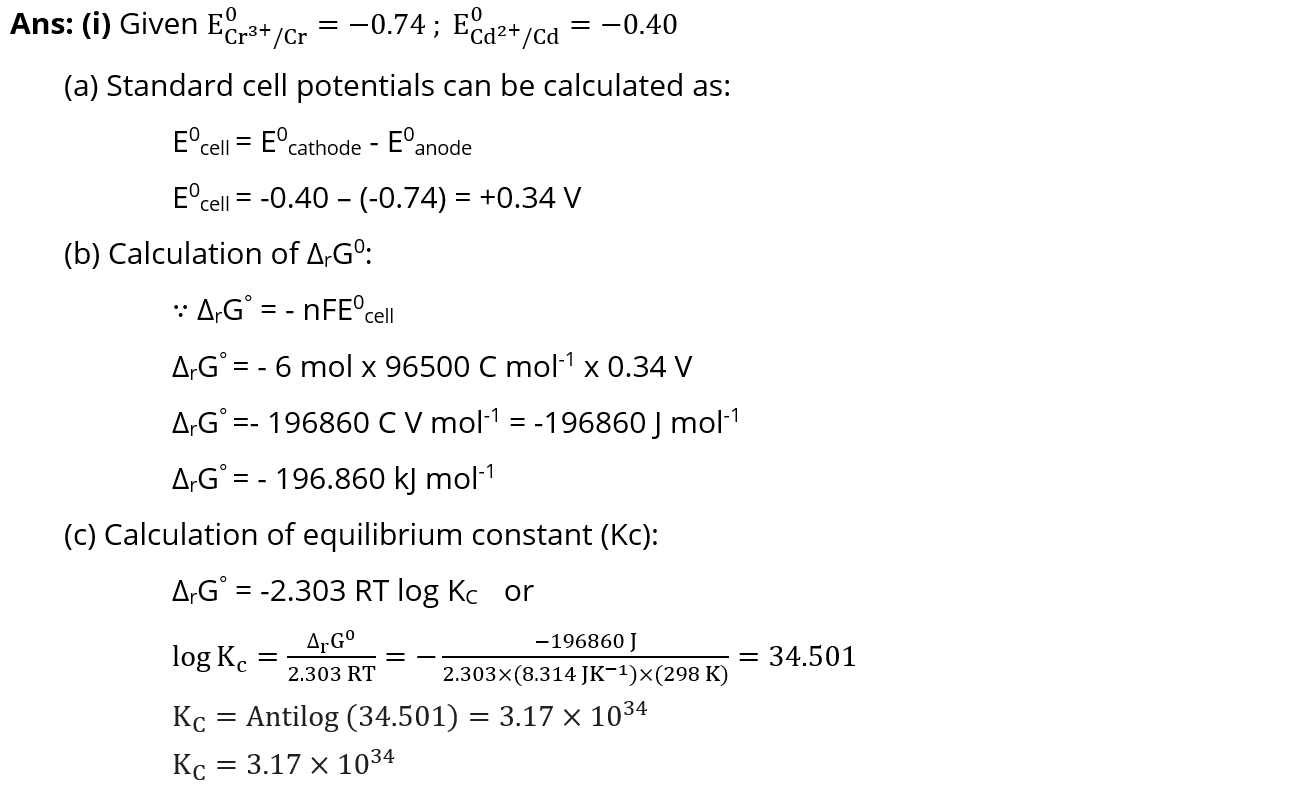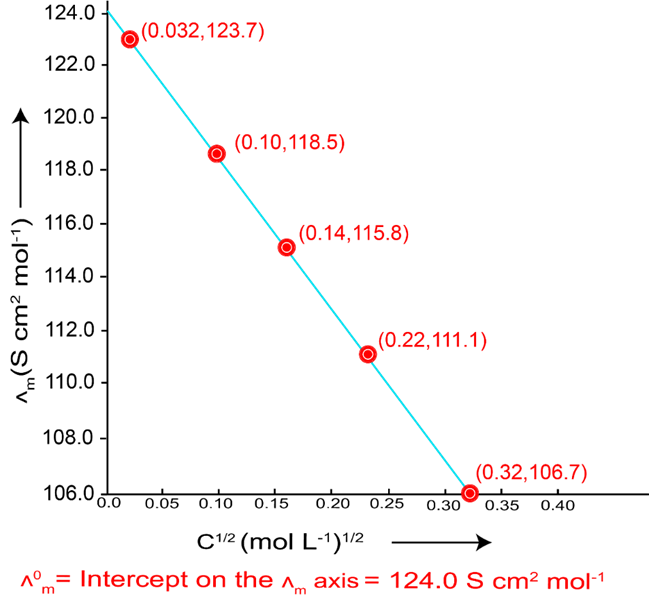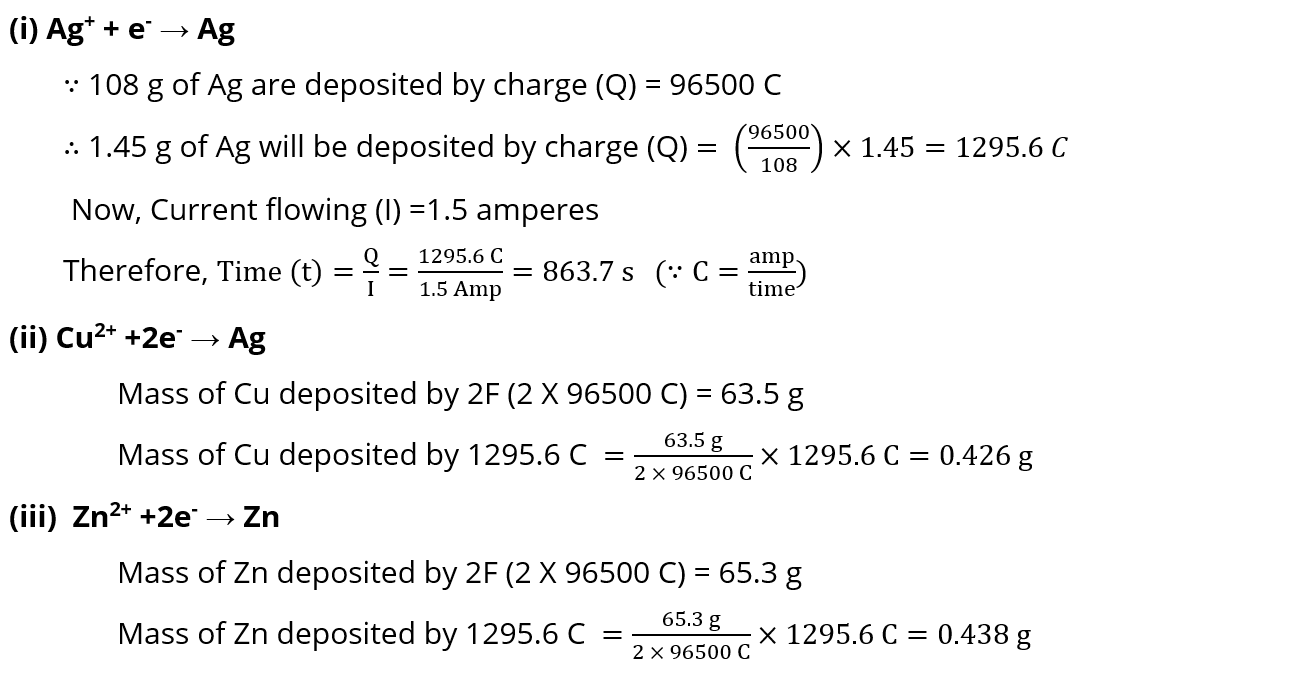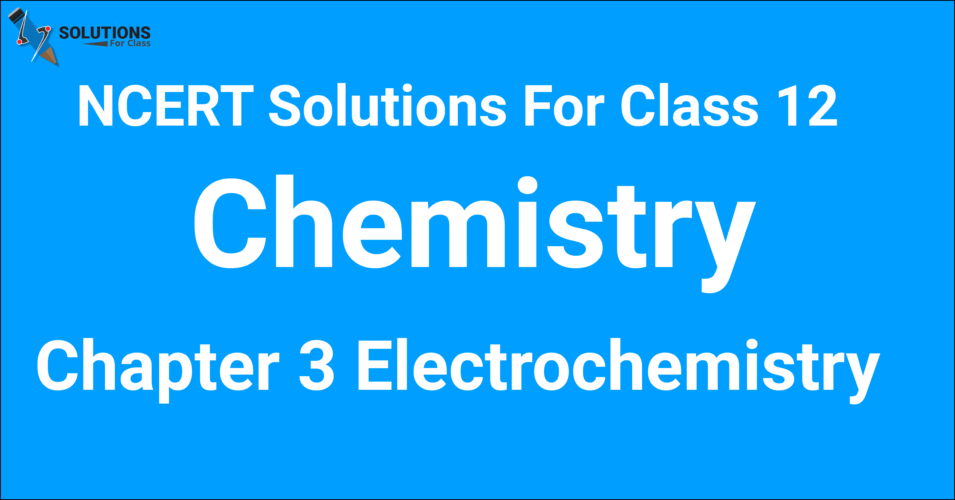NCERT Solutions For Class 12 Chemistry Chapter 3 Electrochemistry: Hello students, in this article we will discuss Chapter 3 Electrochemistry.
Table of Contents
ToggleINTEXT EXERCISE
3.1 How would you determine the standard electrode potential of the system Mg2+|Mg?
Ans: E0 value of Mg2+/Mg electrode is determined by setting up an electrochemical cell. Consisting of a Mg electrode is dipped in 1M MgSO4 solution, which acts as one half cell i.e., oxidation half-cell and standard hydrogen electrode, which acts as one half cell i.e., reduction half-cell.

Now, we can measure the EMF of the cell and also note the direction of deflection in the voltmeter. The direction of deflection shows that electrons flow Mg electrode to hydrogen electrode. Thus, the cell may be represented as follows:
Mg | Mg2+ (1 M) || H+ (1M) | H2 ,(1 atm) | Pt(s)
Hence, the value from voltmeter considered as standard electrode potential of Mg.
3.2 Can you store copper sulphate solutions in a zinc pot?
Ans: No, zinc pot cannot store copper sulphate solutions because the standard electrode potential (E°) value of Zn is less than that of Cu. So, Zn is stronger reducing agent then Cu.

As E°cell is +ve, the reaction will take place and zinc will loss electrons to Cu2+ ions. This will result into degradation of Zn pot. Therefore, we cannot store copper sulphate in zinc pot.
3.3 Consult the table of standard electrode potentials and suggest three substances that can oxidise ferrous ions under suitable conditions.

3.4 Calculate the potential of hydrogen electrode in contact with a solution whose pH is 10.

3.5 Calculate the emf of the cell in which the following reaction takes place:
Ni (s) + 2Ag+ (0.002 M) → Ni2+ (0.160 M) + 2Ag (s) ; Given that E0Cell = 1.05 V.

3.6 The cell in which the following reaction occurs:
2Fe3+(aq) + 2I–(aq) → 2Fe2+(aq) +I2(s) has E0cell = 0.236 V at 298 K, Calculate the standard Gibbs energy and the equilibrium constant of the cell reaction.

3.7 Why does the conductivity of a solution decrease with dilution?
Ans: The conductivity of a solution is due to the number of ions present per unit volume of the solution. When the solution is diluted, the number of ions per unit volume decreases. So, the conductivity also decreases.
3.8 Suggest a way to determine the 𝛬Cm value of water.
Ans: The molar conductance of water at infinite dilution can be obtained from the knowledge of molar conductance at infinite dilution of three strong electrolyte i.e., NaOH, HCl and NaCl.

3.9 The molar conductivity of 0.025 mol L–1 methanoic acid is 46.1 S cm2 mol–1. Calculate its degree of dissociation and dissociation constant.

3.10 If a current of 0.5 ampere flows through a metallic wire for 2 hours, then how many electrons would flow through the wire?

3.11 Suggest a list of metals that are extracted electrolytically.
Ans: Na, Ca, Mg and Al.

3.13 Write the chemistry of recharging the lead storage battery, highlighting all the materials that are involved during recharging.
Ans: When lead storage battery is recharged, electrical energy is supplied to the cell from the external source and act as an electrolytic cell. All the chemical reactions, which take place during the use of battery (i.e., galvanic cell), are reversed at this time. Therefore,

3.14 Suggest two materials other than hydrogen that can be used as fuels in fuel cells.
Ans: Methane (CH4) and methanol (CH3OH).
3.15 Explain how rusting of iron is envisaged as setting up of an electrochemical cell.

NCERT Exercise
3.1 Arrange the following metals in the order in which they displace each other from the solution of their salts. Al, Cu, Fe, Mg and Zn.
Ans: Mg, AI, Zn, Fe and Cu.
3.2 Given the standard electrode potentials, K+/K = –2.93V, Ag+/Ag = 0.80V, Hg2+/Hg = 0.79V Mg2+/Mg = –2.37 V, Cr3+/Cr = – 0.74V , Arrange these metals in their increasing order of reducing power.
Ans: As we know that, lower the reduction potential value, more easily it is oxidised and hence greater is the reducing power. Therefore, the increasing order of reducing power is Ag < Hg < Cr < Mg< K.
3.3 Depict the galvanic cell in which the reaction Zn(s)+2Ag+(aq) → Zn2+(aq) +2Ag(s) takes place. Further show:
(i) Which of the electrode is negatively charged?
(ii) The carriers of the current in the cell.
(iii) Individual reaction at each electrode.
Ans: The cell will be represented as:
Zn(s) | Zn2+ (aq) || Ag+ (aq) | Ag(s)
(i) Zinc electrode (anode) is negatively charged.
(ii) Electrons and ions.
(iii) Individual reaction at each electrode is given below:
At anode: Zn (s) → Zn2+ + 2e–
At cathode: Ag++ e– → Ag (s)



3.5 Write the Nernst equation and emf of the following cells at 298 K:
(i) Mg(s)|Mg2+(0.001M) | | Cu2+(0.0001 M)|Cu(s)
(ii) Fe(s)|Fe2+(0.001M) | | H+(1M)|H2(g)(1bar)| Pt(s)
(iii) Sn(s)|Sn2+(0.050 M) | | H+(0.020 M)|H2 (g) (1 bar)|Pt(s)
(iv) Pt(s)|Br–(0.010 M)|Br2(l ) | | H+(0.030 M)| H2(g) (1 bar)|Pt(s).



3.6 In the button cells widely used in watches and other devices the following reaction takes place: Zn(s) + Ag2O(s) + H2O(l ) → Zn2+(aq) + 2Ag(s) + 2OH–(aq);Determine Δr GӨ and EӨ for the reaction.

3.7 Define conductivity and molar conductivity for the solution of an electrolyte. Discuss their variation with concentration.
Ans: (i) Conductivity (κ): The inverse of resistivity (ρ), is called conductivity.

If l = 1 cm and A = 1 cm2, then κ = G
Therefore, Conductivity of an electrolytic solution may be defined as the conductance of a solution of 1cm length with area of cross-section equal to 1cm2. Its unit is ohm-1cm-1 or S cm-1.
(ii) Molar conductivity (𝛬m): Molar conductivity of a solution at a given concentration is the conductance of the volume (V) of solution containing one mole of electrolyte kept between two electrodes with area of cross section A and at a distance of unit length.

Variation of conductivity and molar conductivity with concentration
Conductivity always decreases with decrease in concentration both, for weak and strong electrolytes. This is so because the number of ions per unit volume that carry the current in a solution decreases on dilution.
Molar conductivity increases with decrease in concentration. This is because the total volume, V of solution containing one mole of electrolyte also increases.
3.8 The conductivity of 0.20 M solution of KCl at 298 K is 0.0248 S cm–1. Calculate its molar conductivity.

3.9 The resistance of a conductivity cell containing 0.001M KCl solution at 298 K is 1500 ohm. What is the cell constant if conductivity of 0.001 M KCl solution at 298 K is 0.146 × 10–3 S cm–1.

3.10 The conductivity of sodium chloride at 298 K has been determined at different concentrations and the results are given below:

Calculate Λm for all concentrations and draw a plot between Λm and c½. Find the value of 𝛬0m.
Ans:


3.11 Conductivity of 0.00241 M acetic acid is 7.896 × 10–5 S cm–1. Calculate its molar conductivity. If for acetic acid is 390.5 S cm2 mol–1, what is its dissociation constant?
Ans:
Conductivity(κ) of acetic acid = 7.896 × 10–5 S cm–1
Conc. of the acetic acid solution = 0.00241 M

3.12 How much charge is required for the following reductions:
(i) 1 mol of Al3+ to Al?
(ii) 1 mol of Cu2+ to Cu?
(iii) 1 mol of MnO4– to Mn2+?
Ans: (i) 1 mol of Al3+ to Al means 3 mol or 3F charge required for reduction.
Al3+ + 3 e– → Al
Quantity of charge required for reduction of 1 mol of Al3+
= 3F = 3 X 96500 C = 289500 C
(ii) 1 mol of Cu2+ to Cu: Cu2+ + 2e– → Cu
Quantity of charge required for reduction of 1 mol of Cu2+
= 2 F = 2 X 96500 C = 19300 C
(iii) 1 mol of MnO4– to Mn2+: MnO4– → Mn2+
Oxidation number of Mn changes from +7 to +2. Therefore, Quantity of charge required
= 5 F = 5 X 96500 C = 482500 C
3.13 How much electricity in terms of Faraday is required to produce
(i) 20.0 g of Ca from molten CaCl2?
(ii) 40.0 g of Al from molten Al2O3?
Ans : (i) Ca2+ + 2e– → Ca
∵40 g of Ca, require electricity = 2F
∴ 20 g of Ca will require electricity = (2/40) x 20 = 1F
(ii) Al3+ + 3e– → Al
∵ 27 g of Al, require electricity = 3F
∴ 40 g of Al will require electricity = (3/27) x 40 = 4.44F
3.14 How many coulombs are required for the following oxidation:
(i) 1 mol of H2O to O2
(ii) 1 mol of FeO to Fe2O3

3.15 A solution of Ni(NO3)2 is electrolysed between platinum electrodes using a current of 5 amperes for 20 minutes. What mass of Ni is deposited at the cathode?

3.16 Three electrolytic cells A,B,C containing solutions of ZnSO4, AgNO3 and CuSO4, respectively are connected in series. A steady current of 1.5 amperes was passed through them until 1.45 g of silver deposited at the cathode of cell B. How long did the current flow? What mass of copper and zinc were deposited?
Ans: Given, I = 1.5 amp, Mass of Ag deposited = 1.45 g


3.17 Using the standard electrode potentials given in Table 3.1, predict if the reaction between the following is feasible:



3.18 Predict the products of electrolysis in each of the following:
(i) An aqueous solution of AgNO3 with silver electrodes.
(ii) An aqueous solution of AgNO3 with platinum electrodes.
(iii) A dilute solution of H2SO4 with platinum electrodes.
(iv) An aqueous solution of CuCl2 with platinum electrodes.
Ans: (i) Electrolysis of aqueous solution of AgNO3 with silver electrodes:
AgNO3 → Ag+ (aq) + NO3– (aq)
H2O ⇌ H+ (aq) + OH– (aq)
At cathode: As Ag+ ions have lower discharge potential than H+ ions. Therefore, Ag+ ions will be deposited as Ag in preference to H+ ions.
At anode: As Ag anode is attacked by NO3– ions, Ag of the anode will dissolve to form Ag+ ions in the solution
Ag → Ag+ (aq) + e–
(ii) Electrolysis of aqueous solution of AgNO3 with platinum electrodes:
At cathode: As Ag+ ions have lower discharge potential than H+ ions. Therefore, Ag+ ions will be deposited as Ag in preference to H+ ions.
At anode: As anode is not attackable, out of OH– and NO3– ions, OH–ions have lower discharge potential. Hence, OH– ions will be discharged in preference to NO3– ions, which will then decompose to give out O2.
OH– → OH +e–, 4OH– → 2H2O + O2
(iii) Electrolysis of dilute H2SO4 with platinum electrodes:
H2SO4 → 2H+ + SO4–
H2O ⇌ H+ + OH–
At cathode H+ ions will be reduced and hydrogen gas is produced.
H+ + e– → H ; H+H→ H2
At anode: OH– → OH +e–, 4OH– → 2H2O + O2
Thus, H2 is liberated at the cathode and O2 at the anode.
(iv) Electrolysis of aqueous solution of CuCl2 with platinum electrodes:
CuCl2 → Cu2+ + 2Cl–
H2O ⇌ H+ + OH–
At cathode: Cu2+ ions will be reduced preferentially due to less discharge potential than H+ ions.
Cu2+(aq) + 2e– → Cu(s) ; Copper metal is deposited at cathode.
At anode Cl– ions will be discharged in preference to OH– ions and chlorine gas is produced at anode. Cl–(aq) → Cl(g) + e– ; Cl +Cl→ Cl2


